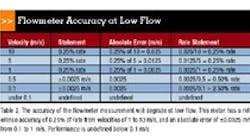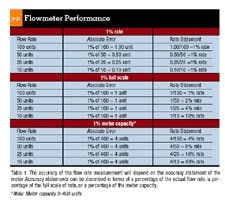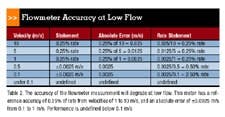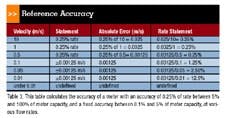Straight-run requirements are relatively short, so magnetic flowmeter technology can be applied where limited straight run is available. In addition, the technology has no Reynolds number constraints, so it can be used for liquids with high or varying viscosity. However, liquid electrical conductivity constraints must be satisfied for these flowmeters to function.
The only wetted parts of the flowmeters are the liner and electrodes, both of which can be made from materials that can withstand corrosion. This makes the flowmeters suitable for use in chemical plants where corrosion may be a concern. Two-wire magnetic flowmeters are available that do not require power wiring. These can replace an existing flowmeter using the existing conduit or wiring with little or no electrical rework.
Principle of operation
Magnetic flowmeters use Faraday's Law of electromagnetic induction to determine the velocity of a liquid flowing through a pipe. Following Faraday's Law, flow of a conductive liquid through a magnetic field will generate a voltage signal. This signal is sensed by electrodes located on the flow tube walls. When the coils are located externally, a non-conductive liner is installed inside the pipe to electrically isolate the electrodes and prevent the signal from being shorted. For similar reasons, non-conductive materials are used to isolate the electrodes for internal coil designs.
The fluid itself is the conductor that will move through the magnetic field and generate a voltage signal at the electrodes. When the fluid moves faster, it generates more voltage. Faraday's Law states that the voltage generated is proportional to the movement of the flowing liquid. The transmitter processes the voltage signal to determine liquid flow.
<Selection factors
Many factors must be considered when selecting a flowmeter, including the ambient conditions to which the flowmeter primary and transmitter will be exposed. For the most part, the ambient temperature rating of the flowmeter primary is higher than that of the transmitter and does not limit applicability. Many primary and transmitter enclosures that are rated for NEMA 4X or IP67 provide adequate protection against ambient humidity and precipitation encountered in outdoor installations.
Operating conditions inside the pipe include pressure, temperature and liquid conductivity. In addition, the liquid can be corrosive or abrasive. These conditions are typically addressed using appropriate mechanical design and material selection. Pressure requirements are addressed by appropriate design of the flow tube for the application. One supplier makes a specially designed magnetic flowmeter that can withstand 1,500 to
2,000 bar (more than 20,000 psi).
Many primaries are available with polytetrafluoroethylene (PTFE) or perfluoroalkoxy (PFA) liners that are rated to about 266 Degrees F and 356 Degrees F
(130 Degrees C and 180 Degrees C), respectively. Less expensive liners rated to lower temperatures are often available to handle less demanding applications. Appropriate electrode and liner material selection can reduce the effects of corrosion and abrasion. Take care when using ceramic liners because they can shatter when temperature gradient constraints are exceeded.
Whereas the conductivity of the liquid in a typical magnetic flowmeter must be maintained above about 5 mixro-Siemens/cm (micro-S/cm), special low-conductivity designs are available that operate as low as about 0.01
micro-S/cm. Some flowmeters require more than 50 micro-S/cm, however, they are low-cost units that are often applied to water or wastewater service where this conductivity is usually not a constraint.
The amount of straight-run pipe required to achieve the stated accuracy of the flowmeter is a reflection of the quality of the design and the tightness of the accuracy specification. In many applications, these flowmeters will function accurately with about three nominal pipe diameters upstream and two nominal pipe diameters downstream of the electrode.
Magnetic flowmeter operation requires good electrical connections between the electrodes and the liquid. The quality of this connection can degrade if an electrode becomes coated or corroded; this can compromise AC flowmeter accuracy by shifting the zero, and may cause the flowmeter to fail to operate. The advent of DC-pulse excitation transmitters reduced much of the need to address this issue. In addition, some manufacturers have designed their transmitters to exhibit a relatively high input impedance to help decrease the effects of connection quality.
Magnetic flowmeter coils can use and store significant amounts of energy relative to the amount of energy needed to cause ignition. Most magnetic flowmeter transmitters are designed to be non-incendive, so normal transmitter operation will not cause ignition. However, when installed in some hazardous locations, formal approval is required, and the transmitter must be designed and installed to address the hazard.
A hazard may be present not only in the general location of the primary and transmitter, but also inside the pipe where the electrodes can provide a source of ignition. To mitigate this hazard, the circuits of some designs limit the energy available at the electrodes to an amount less than that required for ignition.
Maintaining equipment is simplified when self-diagnostics are available to help the user. The extent and quality of the diagnostics and their ease of use varies by manufacturer. Changing ranges is easier and more accurately performed in a digital manner. Potentiometer adjustments and step switches are more prone to problems.
Other considerations
The market for magnetic flowmeters is competitive, so prices are relatively low. Magnetic flowmeters for water and wastewater service can be economical due to the economies of scale and the relatively low cost of liners and electrodes for this service. However, applying magnetic flowmeters to corrosive or abrasive services can significantly increase the cost of the meters.
Magnetic flowmeters for use in the chemical industry are typically more expensive than vortex shedders. In some applications, the cost can rival that of turbine flowmeter or orifice-plate flowmeter systems. Magnetic flowmeters are typically more economical than Coriolis mass flowmeters.
Flowmeter performance
The purpose of installing a flowmeter system is to accurately measure flow in a reliable manner. Issues related to physical properties, process parameters, electronic features and interconnections are often given much consideration. Relatively little emphasis, however, is given as to how well the flowmeter will perform its intended purpose. Adding to the confusion are the differences in how performance is expressed and the incomplete nature of the available information. Nevertheless, the quality of flow measurement should be a concern.
The performance of a flowmeter is quantified by its accuracy statements. The reader must understand not only which parameter is being described, but also the manner in which the statement is expressed. In flow measurement, parameters are commonly described in terms of a percentage of the actual flow rate, a percentage of the full scale of rate, or a percentage of the meter capacity. These terms are mathematically related, so it is possible to convert one to another (Table 1). Note that when compared on a common basis, such as percent of rate, these statements describe significantly different performance.
Other terminology may be used to express these concepts. When this occurs, confirm exactly what the other terms mean so they can be understood.
Performance statements apply to a range of flow or, stated differently, between a minimum and maximum flow velocity. It is important to identify the range in which the statement applies because performance can be significantly degraded or undefined when the flowmeter operates outside of this range.
Complicating the issue are some flowmeters that have different performance statements for different measurement ranges. For example, a flowmeter may have a reference accuracy of 0.25% of rate from velocities of 1 to 10 m/s, and an absolute error of 0.0025 m/s from 0.1 to 1 m/s. Performance is undefined below 0.1 m/s. Table 2 describes this performance using the above information. Note how performance degrades at low flows.
Performance claims
For the most part, the claims made by suppliers regarding magnetic flowmeters are true statements, even though they may seem extraordinary. The problem is that the statement may be incomplete, and may not include certain facts and information that clarify the statement. Sometimes claims are simplified for convenience and easier understanding. However, in many cases, further investigation may reveal other motives for doing so.
For example, consider a magnetic flowmeter that has a reference accuracy of 0.25% of rate and a turndown of 1,000:1. The implication is that the flowmeter can measure within 0.25% of rate over a 1,000:1 range of flow. Taken individually, both parts of the claim are likely true statements. Yet when combined, they can be misleading by omission. Further investigation will show that the reference accuracy of 0.25% of rate applies only within a range of flow rates. Below the minimum flow rate of the range, the reference accuracy becomes a fixed absolute error. So as the flow rate decreases, the accuracy expressed as a percentage of rate will increase.
Assuming that the reference accuracy of 0.25% of rate applies between 5% and 100% of meter capacity, and that between 0.1% and 5% of meter capacity, the reference accuracy is fixed at the absolute error at 5% of meter capacity. Table 3 calculates reference accuracy throughout the range of flows.
This illustrates that above 0.5 m/s, the reference accuracy is 0.25% of rate and that the turndown is 10/0.01 or 1,000:1, both as claimed. What is not stated in the claim is that the reference accuracy degrades below 0.5 m/s and can approach 12.5% of rate. Also not stated is that in actual installations, flows near meter capacity would rarely be encountered, so the 1,000:1 turndown would rarely be achieved. Assuming a more reasonable full-scale calibration range of 0 to 2 m/s, this flowmeter would achieve a 0.25% of rate reference accuracy from 0.5 to 2 m/s, or a 4:1 turndown, and only a 200:1, or 2/0.01, turndown when the stated performance at low flow rates is included.
In addition to high turndown, some suppliers claim that their flowmeter operates at extremely low flow rates. Consider a claim to measure velocity as low as 0.01 m/s. For a meter with a capacity of 10 m/s, this corresponds to a 1,000:1 turndown. Although the flowmeter may operate at this flow rate, Table 3 shows that it does so with a reference accuracy of 12.5% of rate.
Statements about magnetic flowmeters often claim high reference accuracy. What often is not stated is that it may apply over a range of higher flows, and much of this range may not be encountered in actual operation. Furthermore, the reference accuracy as a percentage of rate generally degrades or is undefined at lower flow rates (see tables). When the calibrated full-scale is low, and the high reference accuracy statements are limited to a small range of high flow rates, the stated reference accuracy may not be achieved.
In general, reference accuracy should be clearly and completely stated for all flow rates prior to performing any analysis. The range of applicability of the high accuracy statement and the actual operating flow range should be compared.
Magnetic flowmeters are among the most versatile of flowmeter technologies. However, the user should be aware of the manner in which their application and operation are described in order to ensure that the proper magnetic flowmeter is selected and installed.
David W. Spitzer has more than 25 years of experience in specifying, building, installing, commissioning and troubleshooting process-control instrumentation. Spitzer is a principal in Spitzer and Boyes LLC, which offers consulting services for the process industries in addition to product development, marketing and distribution consulting for manufacturing and automation companies.






